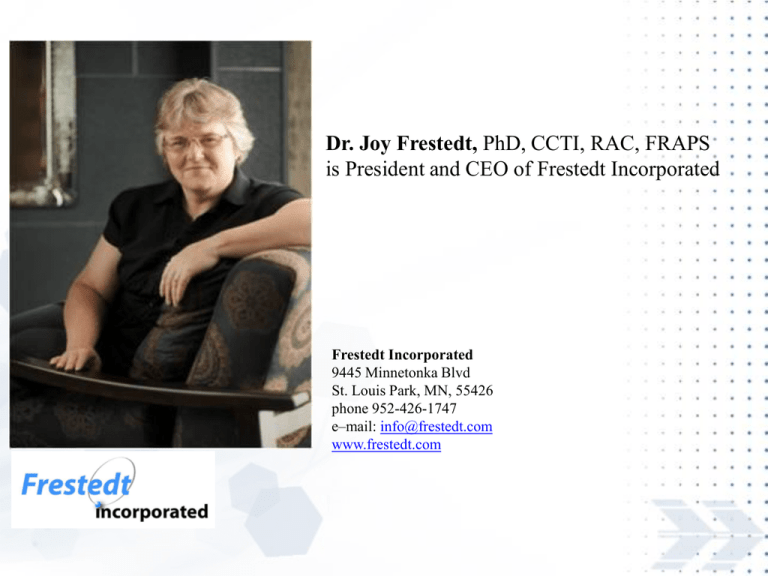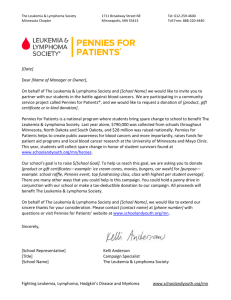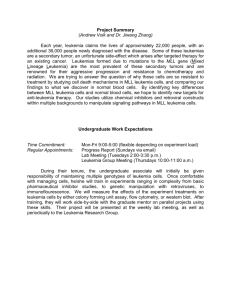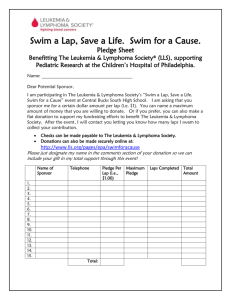PPT Slide Show
advertisement

Dr. Joy Frestedt, PhD, CCTI, RAC, FRAPS is President and CEO of Frestedt Incorporated Frestedt Incorporated 9445 Minnetonka Blvd St. Louis Park, MN, 55426 phone 952-426-1747 e–mail: info@frestedt.com www.frestedt.com Dr. Frestedt holds a BA in biology from Knox College and a PhD in Pathobiology from the University of Minnesota Medical School where she conducted research on infant leukemia. She is a member of the American Society of Clinical Oncologists, American Association of Pharmaceutical Scientists, Association of Clinical Research Professionals, Society of Clinical Research Associates and is a Fellow of the Regulatory Affairs Professionals Society. Dr. Frestedt was named one of the “100 Most Inspiring People in the Life Sciences Industry” by PharmaVOICE and one of the top 25 “Industry Leaders” by the Minneapolis/St. Paul Business Journal in 2011. Dr. Frestedt (Machnicki) Selected Leukemia Publications Clonal Chromosomal Abnormalities Showing Multiple-Cell-Lineage Involvement in Acute Myeloid Leukemia Keinänen M, Griffin JD, Bloomfield CD, Machnicki J, de la Chapelle A. N Engl J Med 1988; 318:1153-1158 Four New Recurring Translocations in Non-Hodgkin Lymphoma Levine EG, Arthur DC, Machnicki J, Frizzera G, Hurd D. Blood 1989 Oct;74(5):1796-1800 Heterogeneity in MLL?AF-4 Fusion Messenger RNA Detected by the Polymerase Chain Reaction in t(4:11) Acute Leukemia Hilden JM, Chen C-S, Moore R, Frestedt J, Kersey JH. Cancer Res 1993;53:3853-3856. Molecular analysis of infant acute lymphoblastic leukemia: MLL gene rearrangement and reverse transcriptasepolymerase chain reaction for t(4; 11)(q21; q23). Hilden JM, Frestedt JL, Moore RO, Heerema NA, Arthur DC, Reaman GH, Kersey JH. Blood. 1995 Nov;86(10):3876-82 AF4/FEL, a gene involved in infant leukemia: sequence variations, gene structure, and possible homology with a genomic sequence on 5q31. Frestedt JL, Hilden JM, Kersey JH. DNA Cell Biol 1996 Aug;15(8):669-78. Differential expression of AF4/FEL mRNA in human tissues. Frestedt JL, Hilden JM, Moore RO, Kersey JH. Genet Anal. 1996 Jan;12(3-4):147-9. Molecular analysis of infant acute leukemia. Hilden JM, Frestedt JL, Kersey JH. Leuk Lymphoma. 1997 Apr;25(3-4):191-9. AF4 encodes a ubiquitous protein that in both native and MLL-AF4 fusion types localizes to subnuclear compartments. Li Q, Frestedt JL, Kersey JH. Blood. 1998 Nov 15;92(10):3841-7. Main Research Interests http://lh3.ggpht.com/_NNjxeW9ewEc/TJiX6h-QeeI/AAAAAAAACFU/aBO_k__9z4w/tmp7645_thumb_thumb.jpg?imgmax=800 • Molecular biology of oncogenic genes and proteins • Common chromosome abnormalities present in infant leukemia, NonHodgkin lymphoma and other cancers • Identification of malignant cell lineages in acute leukemias • Clinical trials to evaluate drug and device therapies • Regulatory submissions of clinical trial data to support new product development • Quality Management System development to meet commercialization needs for drugs, devices and novel foods Chromosomal Translocations Translocations occur when chromosomes break and the pieces of each chromosome rearrange and fuse with the other. This can result in a genetic exchange between two different chromosomes or within one chromosome. Chromosomal translocations can cause genes to fuse together and to produce chimeric mRNAs and proteins. The location of translocations in cancerous cells can help to identify genes involved in regulating the cell cycle and may indicate cancer risk genes. Infant Acute Leukemia and the (4;11) Translocation Infant acute leukemia, developed before 6 months of age, has one of the worst prognoses among leukemia types with a poor response to treatment. Infant leukemia often presents biphenotypically with leukemic cells of both myeloid and lymphoid (i.e. mixed) origin. Molecular analysis of Infant ALL in particular shows that 40-60% of cases involve a specific chromosomal translocation, the t(4;11)(q21;q23) translocation. The breakpoints of this translocation presented putative oncogenes which were studied in detail for their effects on cellular functioning. Two genes often involved in this rearrangement are the AF4/FEL gene and the MLL gene. AF4/FEL and MLL Genes The (4;11)(q21;q23) breakpoint involves two genes, the AF4/FEL gene on chromosome 4 at band 21 and the mixed lineage leukemia (MLL) gene on chromosome 11 at band 23. This particular translocation is associated with some of the worst clinical outcomes in ALL. t(4;11)(q21;23) Analysis and Conclusions Analysis of the 11q23 mixed lineage leukemia (MLL) gene revealed homology to genes regulating development, particularly hematopoesis in other organisms Disruption of the homologous gene in mice resulted in abnormal formation of blood cells, suggesting this gene product’s involvement in human hematopoesis in leukemia Analysis of the 4q21 gene (AF4), MLL’s translocation partner, revealed a serine-rich protein, suggesting a role in nuclear localization. Segments of the AF4 protein were shown to play a role in transcriptional activation These results suggested the rearrangement of MLL and AF4 genes might provide oncogenic potential in infant ALL Non-Hodgkin Lymphoma Non-Hodgkin Lymphoma is a type of cancer that affects lymphocytes (white blood cells). As these cancerous lymphocytes proliferate, they join together and form tumors, called lymphomas, usually located in the lymph nodes. Dr Frestedt used cytogenetic analysis to examine the presence of chromosomal abnormalities in patients with non-Hodgkin lymphoma. By examining the karyotypes of cells from many tumor biopsies, recurring chromosomal translocations in this type of cancer were identified and studied more closely. • • • • • • • • Biopsy tumors from patients with Non-Hodgkin Lymphoma Disaggregate cells and initiate cell culture Harvest cells at appropriate time to capture dividing cells Prepare slides to have optimal metaphase spreads Stain to show selected banding pattern Take photos of metaphase chromosomes and construct karyotypes Identify chromosomes displaying unique polymorphisms and abnormalities Identified four recurring chromosomal translocations in Non-Hodgkin Lymphoma Identified Translocations in NHL A: t(8;9)(q24;p14) Found in patients with diffuse B-cell histologies and visceral disease The 9p13 band contains a NRAS-like gene The 8q24 band contains the MYC oncogene. B: t(11;18)(q21;q21) Found in patients with a small lymphocytic lymphoma and extranodal involvement This translocation was the only karyotypic abnormality found in these patients C: t(14;15)(q32;q15) 10% of NHL patients have a break in the 15q15 band D: der(22)t(17;22)(q11;p11) The 17q11 band has been involved in myeloid and lymphoid leukemias Abnormalities of chromosome 17 have poor prognoses Cytogenetic Analysis t(8;9)(q24;p14) t(14;15)(q32;q15) http://www.elearn.ascp.org/AngelUploads/Content/LQCL1314/_assoc/images/CL_13-14_Figure_7a.jpg t(11;18)(q21;q21) der(22)t(17;22)(q11;p11) Non-Hodgkin Lymphoma Conclusions These recurring translocations indicate sites for genes possibly involved in the development of lymphoma. Two genes, MYC and BLC1 are already being studied intensely as genes of interest and may play an important role in the regulation of lymphoma or other cancer. Other sites discovered at these chromosomal breakpoints present new genes to investigate. Acute Myeloid Leukemia Acute Myeloid Leukemia (AML) is a fast-growing cancer of white blood cells. This cancer most commonly affects adults, but can occur at any age. AML is thought to arise from a single cell which expands clonally. This cancer develops differently in each patient depending on the cell stage of the original cell. If the original cell is already differentiated into a granulocyte or monocyte, all of the resulting cancer cells will be of this cell type. If the cell is an undifferentiated stem cell, the resulting leukemic cells may differentiate into cancerous granulocytes, erythrocytes, megakaryocytes and monocytes. Simultaneous Lineage and Karyotyping In order to analyze the cell lineage of individual cancer cells, we applied antibodies against specific surface proteins to stain the cells in order to differentiate between granulocytes, monocytes, erythrocytes and megakaryocytes. •My-7, Leu M1, and PM-81 antibodies all stained granulocytes/monocytes •Antiglycophorin A stained erythrocytes •Y2/51 and factor VIII identified megakaryocytes Cells arrested in metaphase were stained with antibodies to detect cell type and then karyotyped to observe their chromosomes. By keeping the cell membranes intact we observed which chromosomal abnormalities were present in which cell lineages. By detecting both the lineage and karyotype of cancerous cells, we determined if the cancer cell population was homogenous or heterogeneous. Granulocytes with chromosomal abnormalities were found in all patients examined in this study. These cells stained positive for My7, PM 81, or LeuM1. Over 50% of the cells tested in all patients were positive, showing granulocytes/monocytes dominated the populations of cancerous cells. My-7 positive cell of granulocyte/monocyte lineage with 54 chromosomes (normal is 46) PM-81 positive cell of granulocytic/monocytic lineage from a different patient displaying 47 chromosomes My-7 positive stained cell displaying 45 chromosomes A banded karyotype from the same cell. The arrow points to the deletion of chromosome 7, an abnormality found in a large proportion of patients tested. Monosomy 7, an abnormality present in several patients, was present in all cell lineages tested in these patients. Individuals with monosomy 7 showed this abnormality in all cell types: granulocytes, erythrocytes and megakaryocytes. An antiglycophorin-A positive erythrocytic cell with 45 chromosomes from the same patient. This is one example of a patient displaying different cell lineages with the same chromosomal abnormalities. A Leu-M1 positive granulocytic/monocytic cell displaying 45 chromosomes Acute Myeloid Leukemia: Conclusions In most of the cases examined, karyotypically abnormal cells were present in more than one cell lineage Granulocytic and monocytic cells were present in all cases, and most of the cases also displayed erythrocytic or megakaryocytic cells with the same karyotype The presence of cells from multiple lineages suggest most cases of AML arise from a multipotent progenitor cell rather than a mature, differentiated cell. Currently, Dr. Frestedt works as President and CEO of Frestedt Incorporated, a private consulting firm. Frestedt Inc. offers support tailored to companies producing cancer therapies, drugs, devices, and novel food products. Clinical Research • Clinical Trials • Literature Reviews and Clinical Evidence Reports Regulatory Affairs • Advises to help determine the best path to product approval • Develops documents and submissions for regulatory bodies globally • Negotiates with regulatory authorities to secure product clearance/approval Quality Management Systems • Reviews Quality Management Systems • Develop manuals, standard operating procedures • Train staff to improve company’s ability to withstand audits Case Study 1: Global Clinical Trials • Situation: A large, global company had 20-30 phase 2 clinical trials of a targeted lymphoma treatment and needed assistance compiling the clinical data for regulatory submission. • Frestedt Inc. – developed investigator brochures, technical files, and design dossiers – helped company assemble drug master files – summarized phase 2 trial results – worked with the company headquarters in Japan and numerous sites across the globe • Results: The company narrowed the field of the product targets and completed regulatory discussions based on optimal therapeutic efficacy in the trials Case Study 2: Quality and Compliance • Situation: A clinical trial management software company needed oversight of their quality systems, especially the ability to withstand audits and improve their quality management system (QMS). • Frestedt Inc. – Provided on-site support for all audits including completing pre-audit paperwork/questionnaires and conducting internal audits – After audit completion, created action plan to address observations and acted upon this plan – Provided virtual support to improve QMS including revision of documents to ensure compliance – Revised quality manual, SOPs, work instructions and forms to streamline workflows and documentation practices – Created software development life cycle (SDLC) documentation – Conducted training sessions to review the current regulations and put new quality system documents and processes into practice • Results: Successfully navigated dozens of internal and external audits and developed over 50 quality documents to satisfy auditors. Frestedt continues to work with this client to further develop their quality system and maintain currency with regulatory requirements, audit responses and customer needs.





